Use of Logs Downed by Wildfires as Erosion Barriers to Encourage Forest Auto-Regeneration: A Case Study in Calabria, Italy
Abstract
1. Introduction
2. Materials and Methods
2.1. Description of the Extreme Fire Events in Summer 2021 in Aspromonte Massif, Southern Calabria, Italy
2.2. Study Area Description
2.3. Experimental Scheme
- “Forested” (F): representative of the pre-fire condition;
- “Burned” (B): casually directed downed logs, representative of the post-fire asset;
- “Burned and rearranged” (BR): contour-redirected downed logs, resembling log erosion barriers.
2.4. Data Collection and Processing
2.4.1. Soil
2.4.2. Rainfall
2.4.3. Runoff
2.4.4. Sediment Yield
2.4.5. Vegetation Cover
2.4.6. Statistical Analysis
3. Results and Discussion
3.1. General View of Plot Hydrological Responses
- Event no. 7, which occurred in November 2021, had a cumulative rainfall depth of 249.4 mm and a maximum 5-min rainfall intensity of 30.6 mm h−1. This event occurred over the plots that were only partially covered by vegetation, producing the highest values of runoff volume (15.77 mm) and sediment yield (2076.25 g) from plot-block B.
- Event no. 23, which occurred in August 2022 (105.4 mm, 35.4 mm h−1), generated a runoff volume of 7.03 mm and a sediment yield of 403.65 g (plot-block B).
3.2. Relations between Vegetation Cover Evolution, Runoff, and Sediment Yield after Wildfire
3.3. Comparative Analysis of Runoff and Sediment Yields
4. Conclusions
Author Contributions
Funding
Data Availability Statement
Acknowledgments
Conflicts of Interest
Appendix A
| Month | Event Group | Number of Rainy Days | Cumulated Rainfall Depth (mm) | Maximum 5-min Rainfall Intensity (mm h−1) |
|---|---|---|---|---|
| September 2021 | 1 | 2 | 36.4 | 18.0 |
| 2 | 3 | 15.8 | 13.0 | |
| November | 3 | 6 | 79.6 | 22.4 |
| 4 | 3 | 19.4 | 6.0 | |
| 5 | 3 | 75.2 | 16.0 | |
| 6 | 2 | 14.0 | 4.6 | |
| 7 | 5 | 249.4 | 30.6 | |
| 8 | 5 | 180.2 | 10.2 | |
| November | 9 | 5 | 66.4 | 10.6 |
| 10 | 2 | 33.4 | 9.0 | |
| 11 | 2 | 20.0 | 10.6 | |
| 12 | 4 | 37.2 | 4.4 | |
| December | 13 | 5 | 14.4 | 2.6 |
| 14 | 5 | 70.4 | 7.8 | |
| 15 | 3 | 34.2 | 3.2 | |
| January 2022 | 16 | 6 | 23.8 | 5.4 |
| February | 17 | 3 | 24.4 | 11.4 |
| 18 | 2 | 35.6 | 5.4 | |
| March | 19 | 5 | 58.8 | 3.4 |
| April | 20 | 3 | 14.0 | 2.2 |
| May | 21 | 4 | 53.2 | 7.0 |
| June | 22 | 1 | 17.4 | 4.6 |
| August 2022 | 23 | 7 | 105.4 | 35.4 |
| September 2021–August 2022 (12 months) | 86 | 1278.6 | - | |
| September 2022 | 24 | 2 | 89.0 | 18.6 |
| Overall period | 24 | 88 | 1367.6 | (2.2–35.4) |


References
- Carrión, J.S.; Sánchez-Gómez, P.; Mota, J.F.; Yll, R.; Chaín, C. Holocene Vegetation Dynamics, Fire and Grazing in the Sierra de Gádor, Southern Spain. Holocene 2003, 13, 839–849. [Google Scholar] [CrossRef]
- Hosseini, M.; Keizer, J.J.; Pelayo, O.G.; Prats, S.A.; Ritsema, C.; Geissen, V. Effect of Fire Frequency on Runoff, Soil Erosion, and Loss of Organic Matter at the Micro-Plot Scale in North-Central Portugal. Geoderma 2016, 269, 126–137. [Google Scholar] [CrossRef]
- Fernandez-Anez, N.; Krasovskiy, A.; Müller, M.; Vacik, H.; Baetens, J.; Hukić, E.; Kapovic Solomun, M.; Atanassova, I.; Glushkova, M.; Bogunović, I.; et al. Current Wildland Fire Patterns and Challenges in Europe: A Synthesis of National Perspectives. Air Soil Water Res. 2021, 14, e117862212110281. [Google Scholar] [CrossRef]
- Whelan, R.J. The Ecology of Fire; Cambridge University Press: Cambridge, UK, 1995. [Google Scholar]
- Morgan, P.; Hardy, C.C.; Swetnam, T.W.; Rollins, M.G.; Long, D.G. Mapping Fire Regimes across Time and Space: Understanding Coarse and Fine-Scale Fire Patterns. Int. J. Wildland Fire 2001, 10, 329–342. [Google Scholar] [CrossRef]
- DeBano: Fire Effects on Ecosystems—Google Scholar. Available online: https://scholar.google.com/scholar_lookup?hl=en&publication_year=1998&pages=%00empty%00&author=LF+De+Bano&author=DG+Neary&author=PF+Ffolliott&isbn=%00null%00&title=Fire%27s+Effects+on+Ecosystems (accessed on 25 May 2023).
- Neary, D.G.; Klopatek, C.C.; DeBano, L.F.; Ffolliott, P.F. Fire Effects on Belowground Sustainability: A Review and Synthesis. For. Ecol. Manag. 1999, 122, 51–71. [Google Scholar] [CrossRef]
- Key, C.H.; Benson, N.C. Post-Fire Assessment by Remote Sensing on National Park Service Lands. In Proceedings of the Second U.S. Geological Survey Wildland Fire Workshop, Los Alamos, NM, USA, 31 October–3 November 2000. [Google Scholar]
- Smith, A.M.S.; Hudak, A.T.; Smith, A.M.S.; Hudak, A.T. Estimating Combustion of Large Downed Woody Debris from Residual White Ash. Int. J. Wildland Fire 2005, 14, 245–248. [Google Scholar] [CrossRef]
- Ascoli, D.; Marchetti, M. Territorio, bioeconomia e gestione degli incendi: Una sfida da raccogliere al più presto. For.-J. Silvic. For. Ecol. 2018, 15, 71. [Google Scholar]
- San-Miguel-Ayanz, J.; Durrant, T.; Boca, R.; Maianti, P.; Libertá, G.; Artés-Vivancos, T.; Oom, D.; Branco, A.; de Rigo, D.; Ferrari, D.; et al. Forest Fires in Europe, Middle East and North Africa 2021; Publications Office of the European Union: Luxembourg, 2022. [Google Scholar]
- Shakesby, R. Post-Wildfire Soil Erosion in the Mediterranean: Review and Future Research Directions. Earth-Sci. Rev. 2011, 105, 71–100. [Google Scholar] [CrossRef]
- Dimitrakopoulos, A.; Gogi, C.; Stamatelos, G.; Mitsopoulos, I. Statistical Analysis of the Fire Environment of Large Forest Fires (>1000 Ha) in Greece. Pol. J. Environ. Stud. 2011, 20, 327–332. [Google Scholar]
- Cos, J.; Doblas-Reyes, F.; Jury, M.; Marcos, R.; Bretonnière, P.-A.; Samsó, M. The Mediterranean Climate Change Hotspot in the CMIP5 and CMIP6 Projections. Earth Syst. Dynam. 2022, 13, 321–340. [Google Scholar] [CrossRef]
- Bowman, D.M.; Balch, J.K.; Artaxo, P.; Bond, W.J.; Carlson, J.M.; Cochrane, M.A.; D’Antonio, C.M.; DeFries, R.S.; Doyle, J.C.; Harrison, S.P. Fire in the Earth System. Science 2009, 324, 481–484. [Google Scholar] [CrossRef]
- Mavsar, R.; Varela, E.; Corona, P.; Barbati, A.; Marsh, G. Economic, Legal and Social Aspects of Post-Fire Management. In Post-Fire Management and Restoration of Southern European Forests; Springer: Dordrecht, The Netherlands, 2012; pp. 45–78. [Google Scholar]
- Diakakis, M.; Xanthopoulos, G.; Gregos, L. Analysis of Forest Fire Fatalities in Greece: 1977–2013. Int. J. Wildland Fire 2016, 25, 797–809. [Google Scholar] [CrossRef]
- Elia, M.; Giannico, V.; Spano, G.; Lafortezza, R.; Sanesi, G. Likelihood and Frequency of Recurrent Fire Ignitions in Highly Urbanised Mediterranean Landscapes. Int. J. Wildland Fire 2020, 29, 120–131. [Google Scholar] [CrossRef]
- Barbati, A.; Arianoutsou, M.; Corona, P.; De Las Heras, J.; Fernandes, P.; Moreira, F.; Papageorgiou, K.; Vallejo, R.; Xanthopoulos, G. Post-Fire Forest Management in Southern Europe: A COST Action for Gathering and Disseminating Scientific Knowledge. iForest-Biogeosci. For. 2010, 3, 5. [Google Scholar] [CrossRef]
- Francos, M.; Úbeda, X.; Tort, J.; Panareda, J.M.; Cerdà, A. The Role of Forest Fire Severity on Vegetation Recovery after 18 Years. Implications for Forest Management of Quercus Suber L. in Iberian Peninsula. Glob. Planet. Chang. 2016, 145, 11–16. [Google Scholar] [CrossRef]
- Caon, L.; Vallejo, V.R.; Ritsema, C.J.; Geissen, V. Effects of wildfire on soil nutrients in Mediterranean ecosystems. Earth-Sci. Rev. 2014, 139, 47–58. [Google Scholar] [CrossRef]
- Robinne, F.-N.; Hallema, D.W.; Bladon, K.D.; Buttle, J.M. Wildfire Impacts on Hydrologic Ecosystem Services in North American High-Latitude Forests: A Scoping Review. J. Hydrol. 2020, 581, 124360. [Google Scholar] [CrossRef]
- Scrinzi, G.; Gregori, E.; Giannetti, F.; Galvagni, D.; Zorn, G.; Colle, G.; Andrenelli, M. Un Modello Di Valutazione Della Funzionalità Protettiva Del Bosco per La Pianificazione Forestale: La Componente Stabilità Dei Versanti Rispetto Ai Fenomeni Franosi Superficiali. For.-J. Silvic. For. Ecol. 2006, 3, 98. [Google Scholar] [CrossRef]
- Corona, P.; Barbati, A.; Ferrari, B.; Portoghesi, L. Pianificazione Ecologica Dei Sistemi Forestali: 2a Edizione; Compagnia delle Foreste Srl: Arezzo, Italy, 2019. [Google Scholar]
- Portoghesi, L.; Iovino, F.; Certini, G.; Travaglini, D. II Bosco e La Custodia Del Territorio: II Ruolo Della Selvicoltura. L’Italia For. E Mont. 2019, 74, 263–276. [Google Scholar] [CrossRef]
- Cerdà, A.; Borja, M.E.L.; Úbeda, X.; Martínez-Murillo, J.F.; Keesstra, S. Pinus Halepensis M. versus Quercus Ilex subsp. Rotundifolia L. Runoff and Soil Erosion at Pedon Scale under Natural Rainfall in Eastern Spain Three Decades after a Forest Fire. For. Ecol. Manag. 2017, 400, 447–456. [Google Scholar] [CrossRef]
- Ebel, B.A.; Moody, J.A. Synthesis of Soil-Hydraulic Properties and Infiltration Timescales in Wildfire-Affected Soils. Hydrol. Process. 2017, 31, 324–340. [Google Scholar] [CrossRef]
- García-Comendador, J.; Fortesa, J.; Calsamiglia, A.; Calvo-Cases, A.; Estrany, J. Post-Fire Hydrological Response and Suspended Sediment Transport of a Terraced Mediterranean Catchment. Earth Surf. Process. Landf. 2017, 42, 2254–2265. [Google Scholar] [CrossRef]
- Cavalli, M.; Vericat, D.; Pereira, P. Mapping Water and Sediment Connectivity. Sci. Total Environ. 2019, 673, 763–767. [Google Scholar] [CrossRef] [PubMed]
- Shakesby, R.A.; Doerr, S.H. Wildfire as a Hydrological and Geomorphological Agent. Earth-Sci. Rev. 2006, 74, 269–307. [Google Scholar] [CrossRef]
- Béguin, P.; Millet, J.; Aubert, J.-P. Cellulose Degradation by Clostridium Thermocellum: From Manure to Molecular Biology. FEMS Microbiol. Lett. 1992, 100, 523–528. [Google Scholar] [CrossRef]
- Lasanta, T.; Cerdà, A. Long-Term Erosional Responses after Fire in the Central Spanish Pyrenees: 2. Solute Release. CATENA 2005, 60, 81–100. [Google Scholar] [CrossRef]
- Inbar, M.; Wittenberg, L.; Tamir, M. Soil Erosion and Forestry Management after Wildfire in a Mediterranean Woodland, Mt. Carmel, Israel. Int. J. Wildland Fire 1997, 7, 285–294. [Google Scholar] [CrossRef]
- Inbar, M.; Tamir, M.I.; Wittenberg, L. Runoff and Erosion Processes after a Forest Fire in Mount Carmel, a Mediterranean Area. Geomorphology 1998, 24, 17–33. [Google Scholar] [CrossRef]
- Badía, D.; Martí, C. Plant Ash and Heat Intensity Effects on Chemicaland Physical Properties of Two Contrasting Soils. Arid Land Res. Manag. 2003, 17, 23–41. [Google Scholar] [CrossRef]
- Gimeno-García, E.; Andreu, V.; Rubio, J.L. Influence of Vegetation Recovery on Water Erosion at Short and Medium-Term after Experimental Fires in a Mediterranean Shrubland. Catena 2007, 69, 150–160. [Google Scholar] [CrossRef]
- Mayor, A.G.; Bautista, S.; Llovet, J.; Bellot, J. Post-Fire Hydrological and Erosional Responses of a Mediterranean Landscpe: Seven Years of Catchment-Scale Dynamics. Catena 2007, 71, 68–75. [Google Scholar] [CrossRef]
- Bedia, J.; Herrera, S.; Camia, A.; Moreno, J.M.; Gutiérrez, J.M. Forest Fire Danger Projections in the Mediterranean Using ENSEMBLES Regional Climate Change Scenarios. Clim. Chang. 2014, 122, 185–199. [Google Scholar] [CrossRef]
- Robichaud, P.R.; Ashmun, L.E.; Sims, B.D. Post-Fire Treatment Effectiveness for Hillslope Stabilization; Gen. Tech. Rep. RMRS-GTR-240; U.S. Department of Agriculture, Forest Service, Rocky Mountain Research Station: Fort Collins, CO, USA, 2010; Volume 240, 62p. [Google Scholar] [CrossRef]
- Figueiredo, T.D.; Fonseca, F.; Lima, E.; Fleischfresser, L.; Hernandez Hernandez, Z. Assessing Performance of Post-Fire Hillslope Erosion Control Measures Designed for Different Implementation Scenarios in NE Portugal: Simulations Applying USLE. In Wildfires: Perspectives, Issues and Challenges of the 21st Century; Nova Science Publisher: New York, NY, USA, 2017; pp. 201–227. [Google Scholar]
- Fernández-García, V.; Fulé, P.Z.; Marcos, E.; Calvo, L. The Role of Fire Frequency and Severity on the Regeneration of Mediterranean Serotinous Pines under Different Environmental Conditions. For. Ecol. Manag. 2019, 444, 59–68. [Google Scholar] [CrossRef]
- Robichaud, P.R.; Lewis, S.A.; Wagenbrenner, J.W.; Brown, R.E.; Pierson, F.B. Quantifying Long-Term Post-Fire Sediment Delivery and Erosion Mitigation Effectiveness. Earth Surf. Process. Landf. 2020, 45, 771–782. [Google Scholar] [CrossRef]
- Robichaud, P.R.; Wagenbrenner, J.W.; Lewis, S.A.; Ashmun, L.E.; Brown, R.E.; Wohlgemuth, P.M. Post-Fire Mulching for Runoff and Erosion Mitigation Part II: Effectiveness in Reducing Runoff and Sediment Yields from Small Catchments. Catena 2013, 105, 93–111. [Google Scholar] [CrossRef]
- Robichaud, P.R.; Wagenbrenner, J.W.; Brown, R.E.; Wohlgemuth, P.M.; Beyers, J.L. Evaluating the Effectiveness of Contour-Felled Log Erosion Barriers as a Post-Fire Runoff and Erosion Mitigation Treatment in the Western United States. Int. J. Wildland Fire 2008, 17, 255–273. [Google Scholar] [CrossRef]
- Rey, F.; Bifulco, C.; Bischetti, G.B.; Bourrier, F.; De Cesare, G.; Florineth, F.; Graf, F.; Marden, M.; Mickovski, S.B.; Phillips, C. Soil and Water Bioengineering: Practice and Research Needs for Reconciling Natural Hazard Control and Ecological Restoration. Sci. Total Environ. 2019, 648, 1210–1218. [Google Scholar] [CrossRef]
- USDA Forest Service, C. Emergency Stabilization—Burned-Area Emergency Response (BAER). In Forest Service Manual FSM 2500, Watershed and Air Management; USDA Forest Service: Washingotn, DC, USA, 2004. [Google Scholar]
- Gómez-Sánchez, E.; Lucas-Borja, M.E.; Plaza-Álvarez, P.A.; González-Romero, J.; Sagra, J.; Moya, D.; De Las Heras, J. Effects of Post-Fire Hillslope Stabilisation Techniques on Chemical, Physico-Chemical and Microbiological Soil Properties in Mediterranean Forest Ecosystems. J. Environ. Manag. 2019, 246, 229–238. [Google Scholar] [CrossRef]
- López-Vicente, M.; Kramer, H.; Keesstra, S. Effectiveness of Soil Erosion Barriers to Reduce Sediment Connectivity at Small Basin Scale in a Fire-Affected Forest. J. Environ. Manag. 2021, 278, 111510. [Google Scholar] [CrossRef]
- Raftoyannis, Y.; Spanos, I.; Raftoyannis, Y.; Spanos, I. Evaluation of Log and Branch Barriers as Post-Fire Rehabilitation Treatments in a Mediterranean Pine Forest in Greece. Int. J. Wildland Fire 2005, 14, 183–188. [Google Scholar] [CrossRef]
- Fernández, C.; Vega, J.A.; Jiménez, E.; Fonturbel, T.; Fernández, C.; Vega, J.A.; Jiménez, E.; Fonturbel, T. Effectiveness of Three Post-Fire Treatments at Reducing Soil Erosion in Galicia (NW Spain). Int. J. Wildland Fire 2011, 20, 104–114. [Google Scholar] [CrossRef]
- Preti, F.; Capobianco, V.; Sangalli, P. Soil and Water Bioengineering (SWB) Is and Has Always Been a Nature-Based Solution (NBS): A Reasoned Comparison of Terms and Definitions. Ecol. Eng. 2022, 181, 106687. [Google Scholar] [CrossRef]
- Proto, A.R.; Bernardini, V.; Cataldo, M.F.; Zimbalatti, G. Whole Tree System Evaluation of Thinning a Pine Plantation in Southern Italy. Ann. Silvic. Res. 2020, 45, 44–52. [Google Scholar]
- de Pagter, T.; Lucas-Borja, M.E.; Navidi, M.; Carra, B.G.; Baartman, J.; Zema, D.A. Effects of Wildfire and Post-Fire Salvage Logging on Rainsplash Erosion in a Semi-Arid Pine Forest of Central Eastern Spain. J. Environ. Manag. 2023, 329, 117059. [Google Scholar] [CrossRef] [PubMed]
- Lucas-Borja, M.E.; Heydari, M.; Miralles, I.; Zema, D.A.; Manso, R. Effects of Skidding Operations after Tree Harvesting and Soil Scarification by Felled Trees on Initial Seedling Emergence of Spanish Black Pine (Pinus Nigra Arn. Ssp. Salzmannii). Forests 2020, 11, 767. [Google Scholar] [CrossRef]
- Bombino, G. A (New) Suggestive Hypothesis about the Origin of the Term Fiumara (Seasonally-Flowing and High Hazard Streams of Southern Italy). Mediterr. Chron. 2020, 10, 163–173. [Google Scholar]
- Ibbeken, H.; Schleyer, R. Source and Sediment, a Case Study of Provenance and Mass Balance at an Active Plate Margin (Calabria); Springer Science & Business Media: Berlin/Heidelberg, Germany, 1991. [Google Scholar]
- Sorriso-Valvo, M. Natural Hazards and Natural Heritage—Common Origins and Interference with Cultural Heritage. Geogr. Fis. E Din. Quat. 2008, 31, 231–237. [Google Scholar]
- Palmeri, V.; Pulvirenti, A.; Zappalà, L. La Processionaria Dei Pini Nei Boschi Della Dorsale Appenninica Della Calabria. For.-J. Silvic. For. Ecol. 2005, 2, 345. [Google Scholar] [CrossRef]
- Kottek, M.; Grieser, J.; Beck, C.; Rudolf, B.; Rubel, F. World Map of the Köppen-Geiger Climate Classification Updated. Meteorol. Z. 2006, 15, 259–263. [Google Scholar] [CrossRef]
- Bouyoucos, G.J. Hydrometer Method Improved for Making Particle Size Analyses of Soils1. Agron. J. 1962, 54, 464–465. [Google Scholar] [CrossRef]
- Walkley, A.; Black, I.A. An Examination of the Degtjareff Method for Determining Soil Organic Matter, and A Proposed Modification of the Chromic Acid Titration Method. Soil Sci. 1934, 37, 29. [Google Scholar] [CrossRef]
- Kjeldahl, J. Neue Methode zur Bestimmung des Stickstoffs in organischen Körpern. Z. Für Anal. Chem. 1883, 22, 366–382. [Google Scholar] [CrossRef]
- Tomaščík, M.; Németová, Z.; Danacova, M. Analysis of Factors Influencing the Intensity of Soil Water Erosion. Acta Hydrol. Slovaca 2021, 22, 70–77. [Google Scholar] [CrossRef]
- Tinebra, I.; Alagna, V.; Iovino, M.; Bagarello, V. Comparing Different Application Procedures of the Water Drop Penetration Time Test to Assess Soil Water Repellency in a Fire Affected Sicilian Area. Catena 2019, 177, 41–48. [Google Scholar] [CrossRef]
- Roldán, A.; García-Orenes, F.; Lax, A. An Incubation Experiment to Determine Factors Involving Aggregation Changes in an Arid Soil Receiving Urban Refuse. Soil Biol. Biochem. 1994, 26, 1699–1707. [Google Scholar] [CrossRef]
- Benito Rueda, E.; Gomez Ulla, A.; Diaz Fierros, F. Descripción de Un Simulados de Lluvia Para Estudios de Erodabilidad Del Suelo y Estabilidad de Los Agregados al Agua. An. Edafol. Agrobiol 1986, 45, 1115–1126. [Google Scholar]
- Ball, D.F. Loss-on-Ignition as an Estimate of Organic Matter and Organic Carbon in Non-Calcareous Soils. J. Soil Sci. 1964, 15, 84–92. [Google Scholar] [CrossRef]
- Vogel, K.P.; Masters, R.A. Frequency Grid-a Simple Tool for Measuring Grassland Establishment. J. Range Manag. 2001, 54, 653–655. [Google Scholar] [CrossRef]
- Braun-Blanquet, J. Zur Kenntnis Der Vegetationsverhältnisse Des Grossen Atlas; Buchdruckerei Gebr. Fretz AG: Zürich, Switzerland, 1928. [Google Scholar]
- Keesstra, S.D.; Maroulis, J.; Argaman, E.; Voogt, A.; Wittenberg, L. Effects of Controlled Fire on Hydrology and Erosion under Simulated Rainfall. Cuad. Investig. Geográfica 2014, 40, 269–294. [Google Scholar] [CrossRef]
- Lucas-Borja, M.E.; Van Stan II, J.T.; Heydari, M.; Omidipour, R.; Rocha, F.; Plaza-Alvarez, P.A.; Zema, D.A.; Muñoz-Rojas, M. Post-Fire Restoration with Contour-Felled Log Debris Increases Early Recruitment of Spanish Black Pine (Pinus Nigra Arn. ssp. Salzmannii) in Mediterranean Forests. Restor. Ecol. 2021, 29, e13338. [Google Scholar] [CrossRef]
- Ferro, V. Evaluating Overland Flow Sediment Transport Capacity. Hydrol. Process. 1998, 12, 1895–1910. [Google Scholar] [CrossRef]
- Pampalone, V.; Carollo, F.G.; Nicosia, A.; Palmeri, V.; Di Stefano, C.; Bagarello, V.; Ferro, V. Measurement of Water Soil Erosion at Sparacia Experimental Area (Southern Italy): A Summary of More than Twenty Years of Scientific Activity. Water 2022, 14, 1881. [Google Scholar] [CrossRef]
- Mendes, T.A.; Alves, R.D.; Gitirana, G.D.F.N., Jr.; Pereira, S.A.D.S.; Rebolledo, J.F.R.; da Luz, M.P. Evaluation of Rainfall Interception by Vegetation Using a Rainfall Simulator. Sustainability 2021, 13, 5082. [Google Scholar] [CrossRef]
- Wittenberg, L.; Inbar, M. The Role of Fire Disturbance on Runoff and Erosion Processes—A Long-Term Approach, Mt. Carmel Case Study, Israel. Geogr. Res. 2009, 47, 46–56. [Google Scholar] [CrossRef]
- Rulli, M.C.; Spada, M.; Bozzi, S.; Bocchiola, D.; Rosso, R. Erosion and Runoff Generation from Fire Disturbed Mediterranean Forest Area. Ph.D. Thesis, Colorado State University, Fort Collins, CO, USA, 2005. [Google Scholar] [CrossRef]
- Rubio, J.L.; Forteza, J.; Andreu, V.; Cerni, R. Soil Profile Characteristics Influencing Runoff and Soil Erosion after Forest Fire: A Case Study (Valencia, Spain). Soil Technol. 1997, 11, 67–78. [Google Scholar] [CrossRef]
- Campo, J.; Andreu, V.; Gimeno-García, E.; González, O.; Rubio, J.L. Occurrence of Soil Erosion after Repeated Experimental Fires in a Mediterranean Environment. Geomorphology 2006, 82, 376–387. [Google Scholar] [CrossRef]
- Li, L.; Yang, J.; Wu, J. A Method of Watershed Delineation for Flat Terrain Using Sentinel-2A Imagery and DEM: A Case Study of the Taihu Basin. ISPRS Int. J. Geo-Inf. 2019, 8, 528. [Google Scholar] [CrossRef]
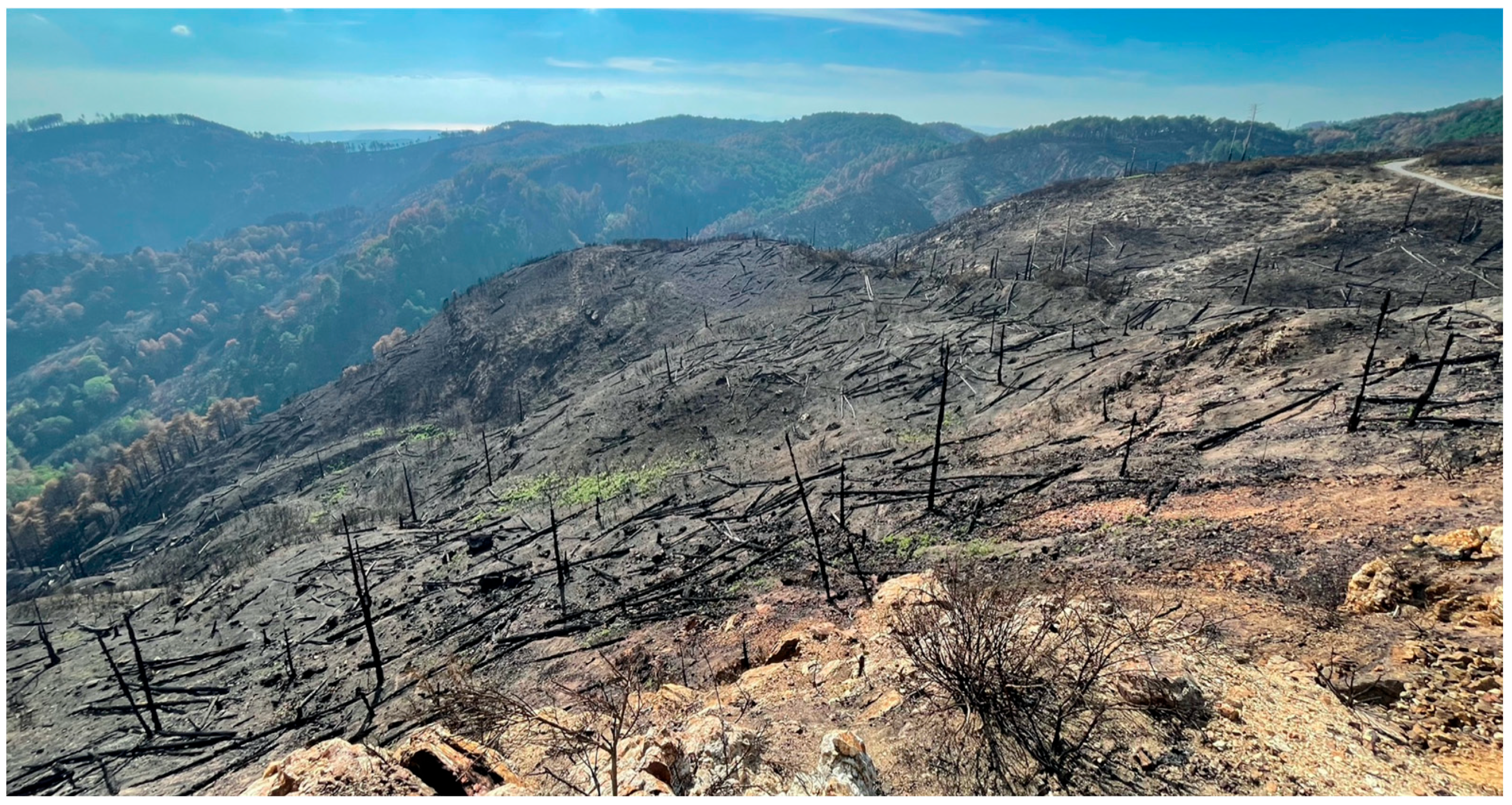
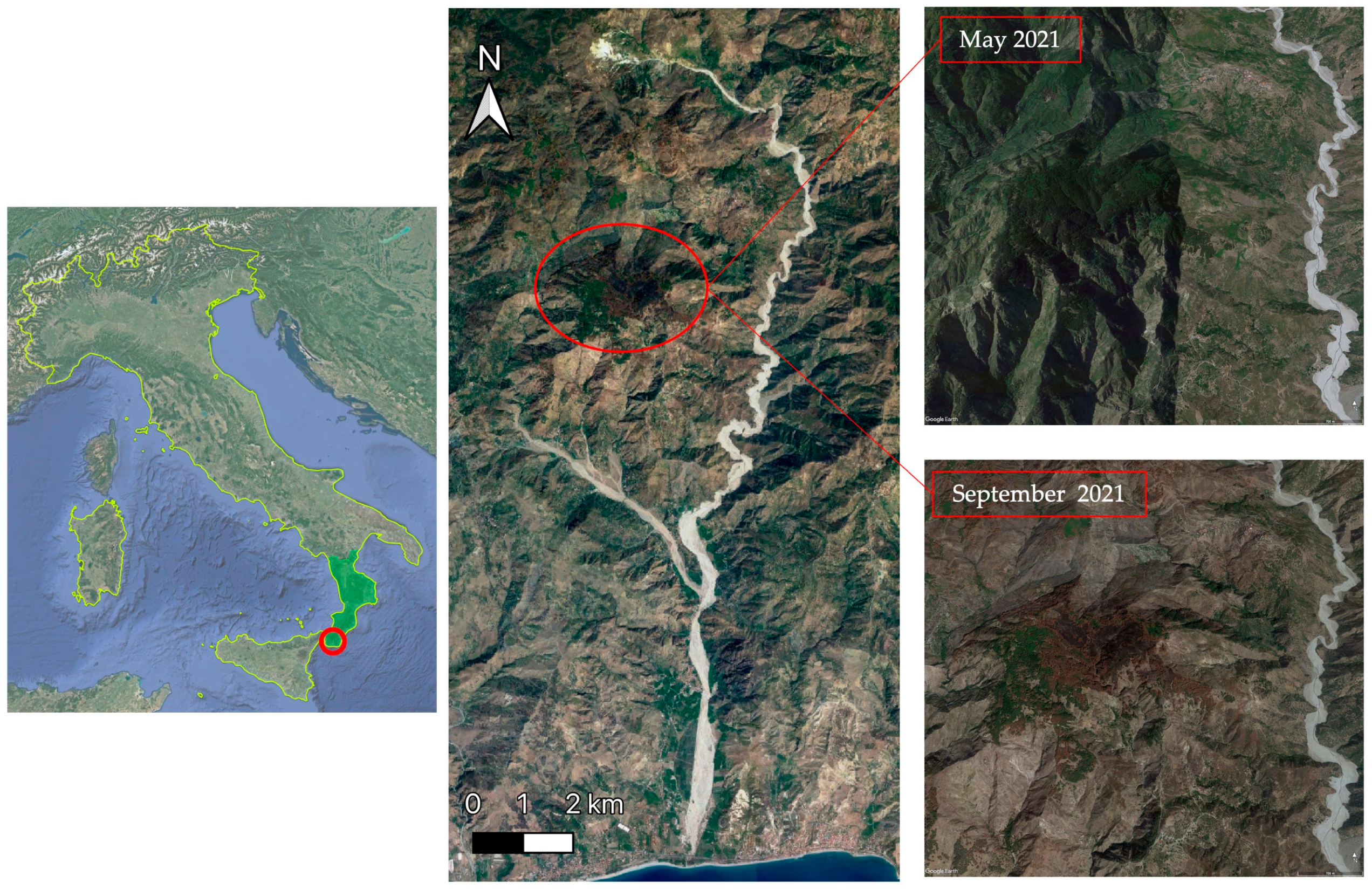
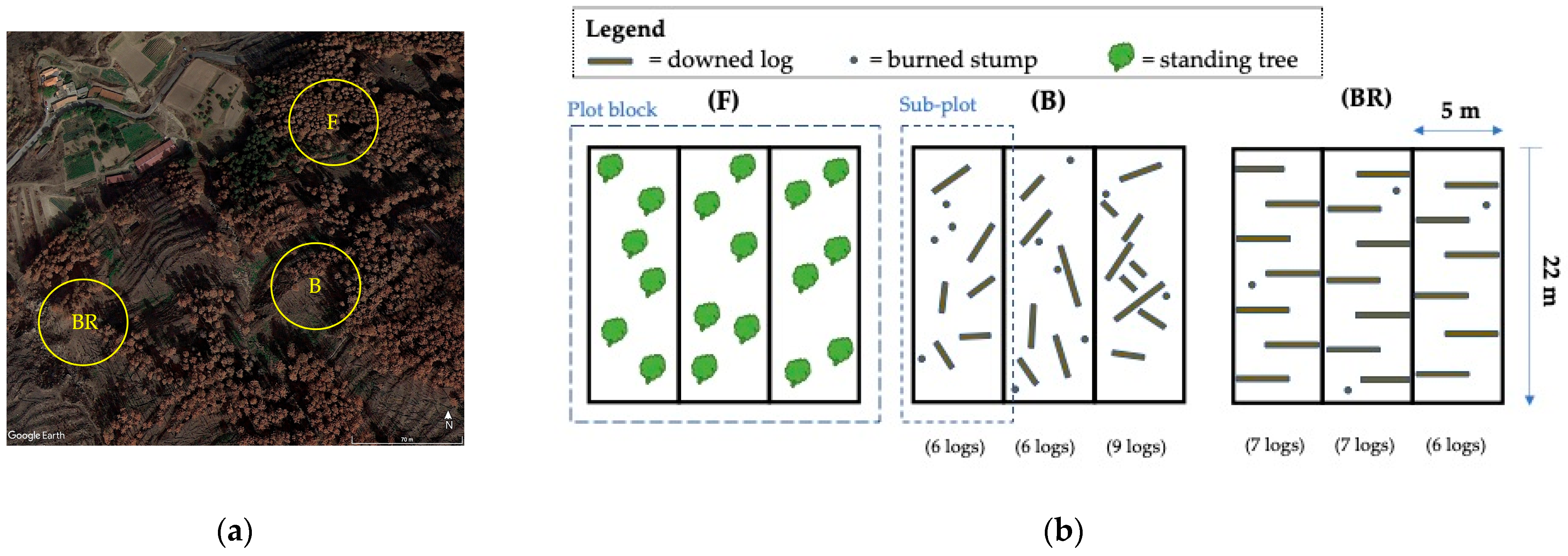
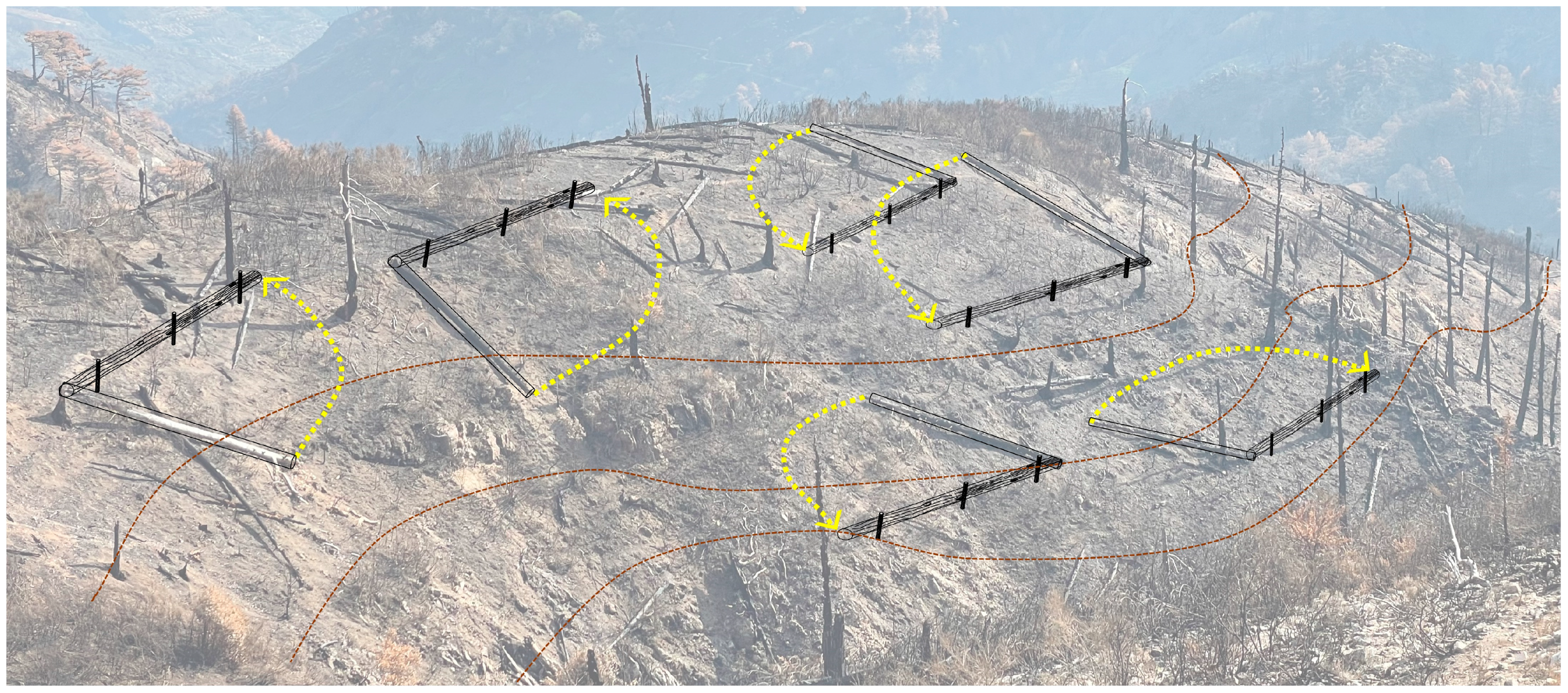

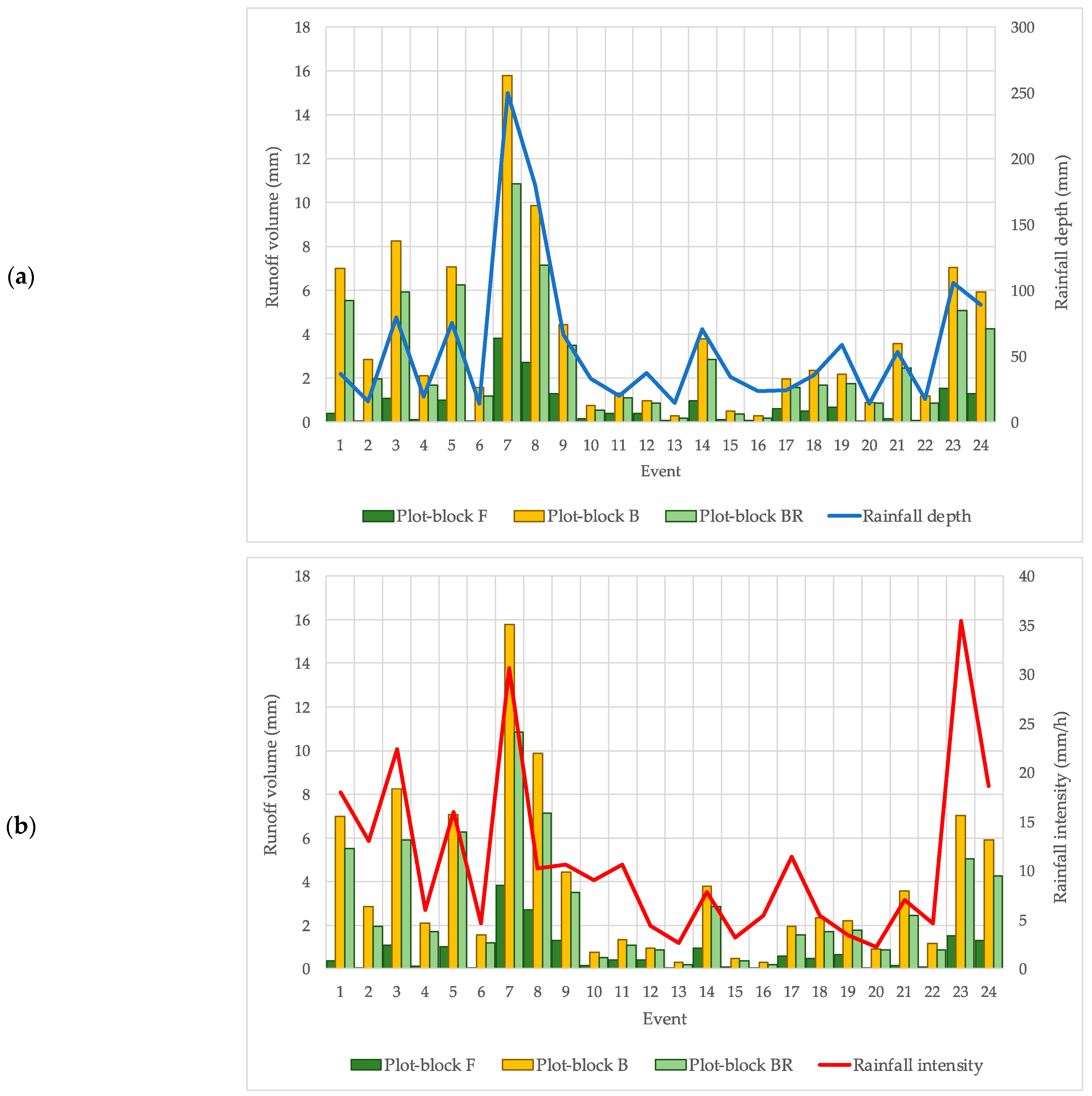
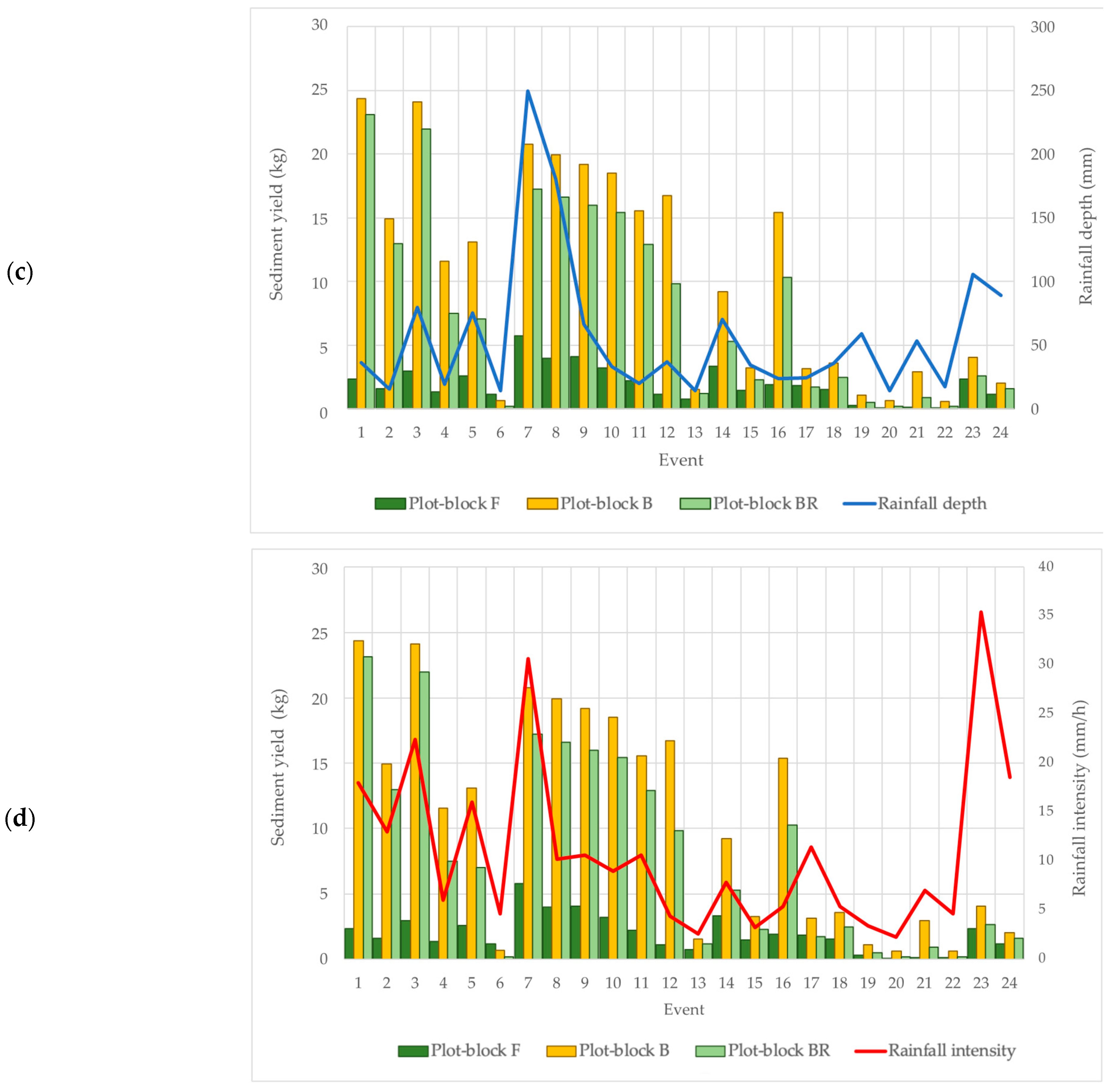
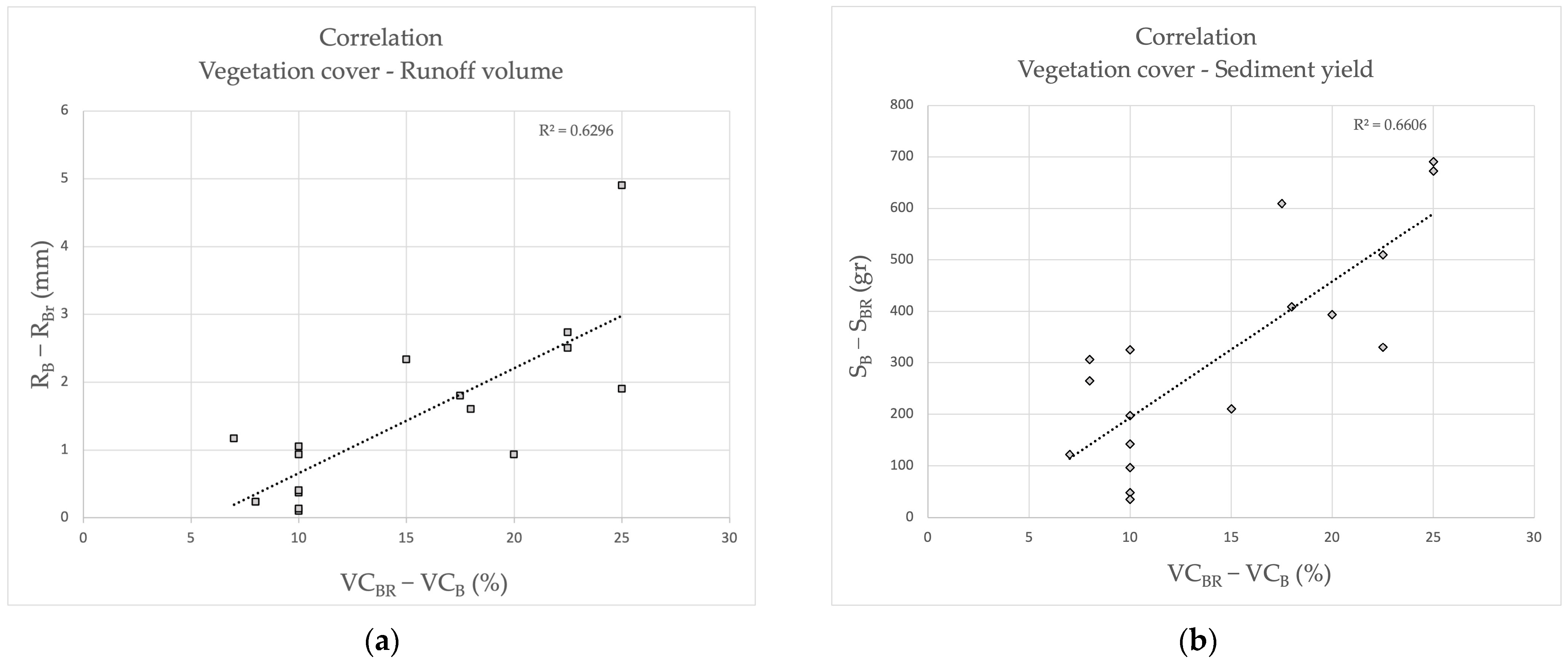
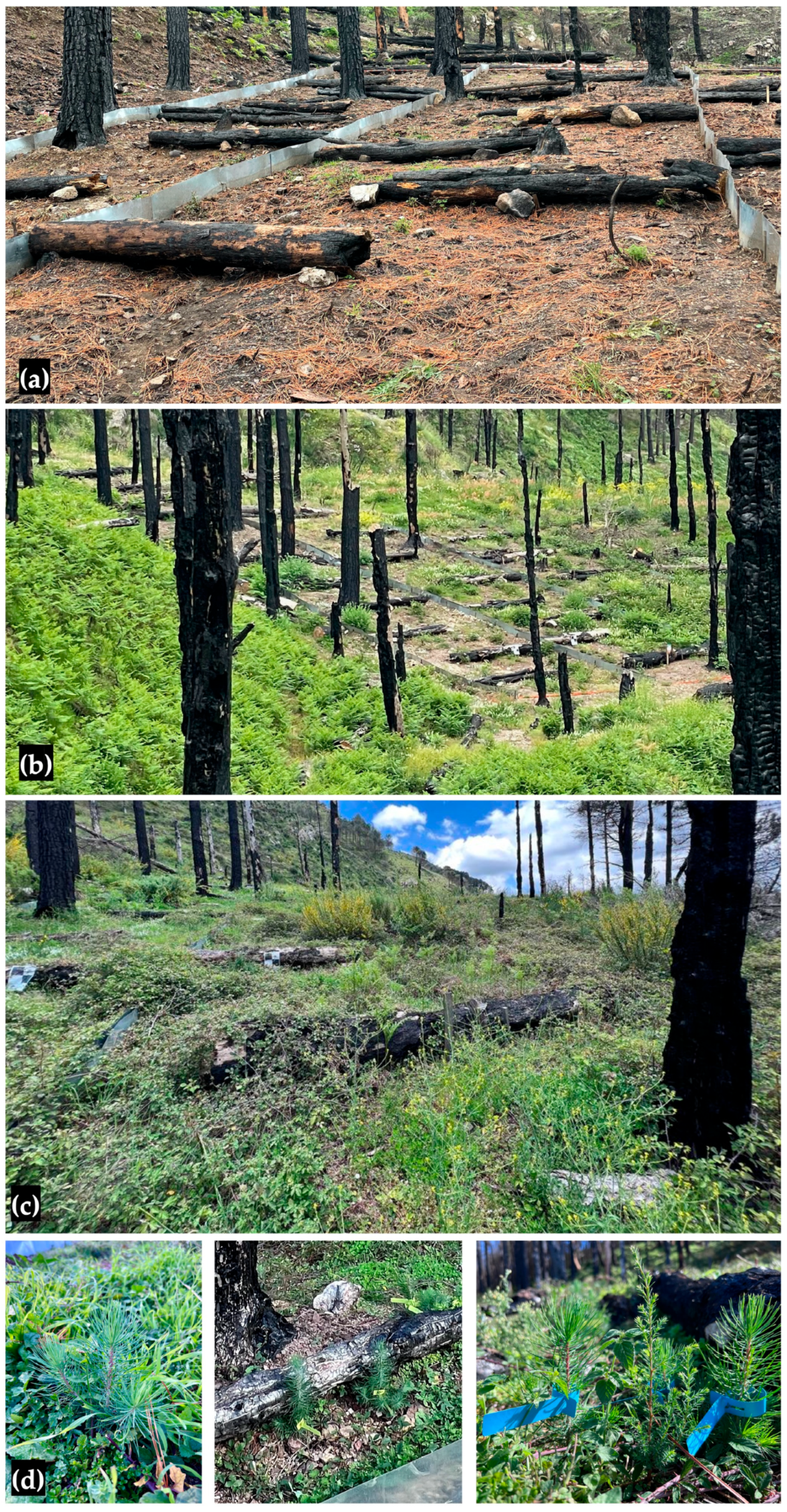
| Orography | Coordinates | 38°03′ N; 15°54′ E |
| Altitude | 970 m a.s.l. | |
| Aspect | North | |
| Climate | Condition (according to the Köppen classification [59]) | Csa 1 |
| Mean monthly air temperature * | 5 °C (January)–23 °C (August) | |
| Mean annual rainfall depth * | 1036 mm | |
| Mean monthly rainfall depth range * | 13.7 mm (July)–153 mm (December) | |
| Forestsetting | Species | Pinus radiata |
| Density | 800–1000 per ha | |
| Height | 14–20 m | |
| Crown diameter | 4–7.5 m |
| Physical/Chemical Features | Plot-Block | |||||
|---|---|---|---|---|---|---|
| F | B | BR | ||||
 | 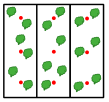 | 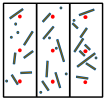 | 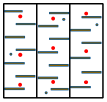 | |||
| Silt | (%) | 9.4 ± 1.1 | ||||
| Clay | (%) | 11.7 ± 0.1 | ||||
| Sand | (%) | 78.9 ± 0.94 | ||||
| pH | 5.76 ± 0.2 | 6.19 ± 0.3 | 6.21 ± 0.3 | |||
| EC1:1 (dS/m) | 0.199 ± 0.043 | 0.202 ± 0.031 | 0.274 ± 0.047 | |||
| Organic matter | (%) | 3.38 | 2.98 | 2.96 | ||
| C | (%) | 1.96 ± 0.2 | 1.72 ± 0.1 | 1.71 ± 0.1 | ||
| N | (%) | 0.79 ± 0.1 | 0.83 ± 0.0 | 0.83 ± 0.0 | ||
| C:N | 22.8 | 25.3 | 26.1 | |||
| Mean infiltration rate | (mm h−1) | 23.8 | 16.1 | 15.8 | ||
| Soil water repellency | 39.6 | 93.6 | 94.3 | |||
| Ash cover | (%) | 0.0 | 47.0 ± 4.8 | 46.6 ± 5.1 | ||
| AS (n = 3) | Size fraction (mm) | 0.25–0.50 | (%) | 78 ± 1.0 | 72 ± 1.3 | 72 ± 1.2 |
| 0.50–1.0 | 83 ± 1.4 | 76 ± 1.4 | 76 ± 1.3 | |||
| 1.0–2.0 | 31 ± 1.4 | 28 ± 1.2 | 28 ± 1.3 | |||
| Runoff Volume (mm) | Sediment Yield (kg) | |||||
|---|---|---|---|---|---|---|
| Plot F | Plot B | Plot BR | Plot F | Plot B | Plot BR | |
| Mean | 0.73 | 3.84 | 2.87 | 0.196 | 1.028 | 0.791 |
| Median | 0.40 | 2.29 | 1.73 | 0.171 | 1.040 | 0.615 |
| Standard deviation | 0.93 | 3.77 | 2.70 | 0.141 | 0.838 | 0.746 |
| Minimum | 0.02 | 0.30 | 0.20 | 0.007 | 0.060 | 0.018 |
| Maximum | 3.84 | 15.82 | 10.87 | 0.575 | 2.434 | 2.312 |
| Shapiro–Wilk p | <0.001 | <0.001 | 0.002 | 0.199 | 0.007 | 0.007 |
| Runoff | Sediments | ||||||
|---|---|---|---|---|---|---|---|
| Plot F | Plot B | Plot BR | Plot F | Plot B | Plot BR | ||
| Rainfall depth | Spearman Rho | 0.93 *** | 0.79 *** | 0.78 *** | 0.57 ** | 0.47 * | 0.43 * |
| p value | < 0.001 | < 0.001 | <0.001 | 0 | 0.02 | 0.04 | |
| Rainfall intensity | Spearman Rho | 0.66 *** | 0.78 *** | 0.77 *** | 0.67 *** | 0.58 ** | 0.6 ** |
| p value | <0.001 | <0.001 | <0.001 | <0.001 | 0 | 0 | |
| Kruskal-Wallis | Rainfall Depth | Rainfall Intensity | ||||||
|---|---|---|---|---|---|---|---|---|
| χ2 | gl | p | ε2 | χ2 | gl | p | ε2 | |
| Plot F | 16.6 | 2 | <0.001 | 0.724 | 10.4 | 2 | 0.005 | 0.453 |
| Plot B | 16.6 | 2 | <0.001 | 0.723 | 12.3 | 2 | 0.002 | 0.537 |
| Plot BR | 16.2 | 2 | <0.001 | 0.706 | 12.2 | 2 | 0.002 | 0.530 |
| Pairwise Comparisons (Dwass Steel Critchlow-Fligner) | Rainfall Depth | Rainfall Intensity | |||||||||||
|---|---|---|---|---|---|---|---|---|---|---|---|---|---|
| Plot F | Plot B | Plot BR | Plot F | Plot B | Plot BR | ||||||||
| W | p | W | p | W | p | W | p | W | p | W | p | ||
| Category 1 | Category 2 | 3.63 | 0.028 | 3.56 | 0.032 | 3.50 | 0.036 | 3.59 | 0.030 | 4.30 | 0.007 | 4.30 | 0.007 |
| Category 1 | Category 3 | 4.94 | 0.001 | 4.93 | 0.001 | 4.94 | 0.001 | 3.13 | 0.069 | 3.13 | 0.070 | 3.14 | 0.068 |
| Category 2 | Category 3 | 3.54 | 0.033 | 3.64 | 0.027 | 3.43 | 0.040 | 2.67 | 0.142 | 2.00 | 0.334 | 1.67 | 0.466 |
| Plot | Rainfall Depth | Rainfall Intensity | ||||||
|---|---|---|---|---|---|---|---|---|
| χ2 | gl | p | ε2 | χ2 | df | p | ε2 | |
| Plot F | 6.34 | 2 | 0.042 | 0.276 | 8.36 | 2 | 0.015 | 0.364 |
| Plot B | 3.12 | 2 | 0.211 | 0.135 | 6.35 | 2 | 0.042 | 0.276 |
| Plot BR | 2.44 | 2 | 0.295 | 0.106 | 7.26 | 2 | 0.027 | 0.316 |
| Pairwise Comparisons (Dwass Steel Critchlow-Fligner) | Rainfall Depth | Rainfall Intensity | |||||||||||
|---|---|---|---|---|---|---|---|---|---|---|---|---|---|
| Plot F | Plot B | Plot BR | Plot F | Plot B | Plot BR | ||||||||
| W | p | W | p | W | p | W | p | W | p | W | p | ||
| Category 1 | Category 2 | 0.142 | 0.994 | 1.706 | 0.450 | 1.14 | 0.701 | 3.54 | 0.033 | 3.35 | 0.047 | 3.64 | 0.027 |
| Category 1 | Category 3 | 3.522 | 0.034 | 2.241 | 0.252 | 2.11 | 0.294 | 2.64 | 0.148 | 1.92 | 0.363 | 1.92 | 0.363 |
| Category 2 | Category 3 | 2.424 | 0.200 | 0.808 | 0.836 | 1.01 | 0.755 | 1.33 | 0.614 | 0.00 | 1.000 | 0.00 | 1.000 |
Disclaimer/Publisher’s Note: The statements, opinions and data contained in all publications are solely those of the individual author(s) and contributor(s) and not of MDPI and/or the editor(s). MDPI and/or the editor(s) disclaim responsibility for any injury to people or property resulting from any ideas, methods, instructions or products referred to in the content. |
© 2023 by the authors. Licensee MDPI, Basel, Switzerland. This article is an open access article distributed under the terms and conditions of the Creative Commons Attribution (CC BY) license (https://creativecommons.org/licenses/by/4.0/).
Share and Cite
Bombino, G.; Barbaro, G.; Pérez-Cutillas, P.; D’Agostino, D.; Denisi, P.; Foti, G.; Zimbone, S.M. Use of Logs Downed by Wildfires as Erosion Barriers to Encourage Forest Auto-Regeneration: A Case Study in Calabria, Italy. Water 2023, 15, 2378. https://doi.org/10.3390/w15132378
Bombino G, Barbaro G, Pérez-Cutillas P, D’Agostino D, Denisi P, Foti G, Zimbone SM. Use of Logs Downed by Wildfires as Erosion Barriers to Encourage Forest Auto-Regeneration: A Case Study in Calabria, Italy. Water. 2023; 15(13):2378. https://doi.org/10.3390/w15132378
Chicago/Turabian StyleBombino, Giuseppe, Giuseppe Barbaro, Pedro Pérez-Cutillas, Daniela D’Agostino, Pietro Denisi, Giandomenico Foti, and Santo Marcello Zimbone. 2023. "Use of Logs Downed by Wildfires as Erosion Barriers to Encourage Forest Auto-Regeneration: A Case Study in Calabria, Italy" Water 15, no. 13: 2378. https://doi.org/10.3390/w15132378
APA StyleBombino, G., Barbaro, G., Pérez-Cutillas, P., D’Agostino, D., Denisi, P., Foti, G., & Zimbone, S. M. (2023). Use of Logs Downed by Wildfires as Erosion Barriers to Encourage Forest Auto-Regeneration: A Case Study in Calabria, Italy. Water, 15(13), 2378. https://doi.org/10.3390/w15132378











